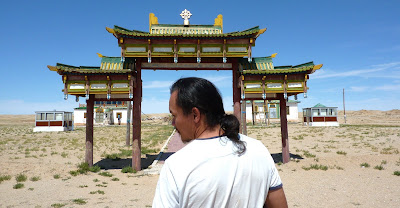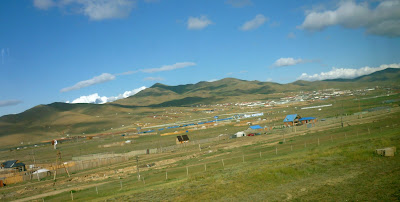 |
| THE GOBI: FULL OF EMPTY |
Our visits to the various Co-Operatives and Zamiin Yyl have given us an opportunity to conduct a Resource Inventory, to identify areas of greatest need where we can make the biggest impact in the short time we will have to work with the Co-Operative leaders and Members who have been selected to attend the Gobi training.
The Resource Inventory is a formal tool created by David Holmgren [with input from Ian Lillington, author of ‘The Holistic Life’], and is like a SWOT Analysis for Permaculture Designers …and anyone working in Sustainable Aid.
Really, it’s just a written version of what I have watched Rick do unconsciously since the moment we stepped off the plane:
Stage 1, Observation: What do we have to work with right now?
Take inventory of all available resources, including Landscape, Infrastructure, Household, and Culture
Stage 2, Evaluation: What can it be used for?
List all possible functions of available resources.
Stage 3, Strategy: What can we do with it?
Explore possible ways to harness, use, and direct available resources.
Stage 4, Design: How can we connect it?
Explore possible ways to connect strategies create energy cycles and maximize multi-functions.
Stage 5, Implementation: Who? What? Where? When? How Much?
Explore logistics and practicalities towards putting strategies and designs into effect right now.
Stages 1 and 2 are like a massive information gathering / brainstorming session and can be done with just initial team members; we spent the first two weeks of this trip doing just this.
Stages 3 – 5 can only be effectively done with input from local stakeholders; this local knowledge and skill base is the biggest asset a Sustainable Aid Worker has.
By working with what is already locally available, resources can be re-organized into design solutions that can be easily adopted, adapted, and evolved by communities.
Similarly, knowledge can be more easily transferred and new skills more readily developed if they are culturally appropriate.
 |
| GOBI HASHA, TAKEN FROM TOP OF PASSIVE SOLAR GREENHOUSE |
Communities take ownership in ideas they have come up with for themselves, and teaching concepts rather than lecturing formulae & information will empower & encourage individual thought experimentation within a sustainable design framework, supporting forward movement and problem-solving without the need for constant supervision & trouble-shooting.
A positive feedback loop is created, and learning curves accelerated because students now have a holistic design framework in which to observe, ask the right questions, then filter and organize information through this base foundation.
Risk is managed through careful thought, and informed, small-scale implementation in experimental plots. Mistakes are confined to these smaller areas [rather than risking an entire crop], and become stepping stones to learning:
- What worked?
- Why did this work?
- What didn’t work?
- Why didn’t this work?
- How can we improve?
When designing a course for a new culture, or as in this context, for a different community within a culture, this process of:
- Constant gathering of information
- Evaluating what can be done with available resources
- Strategizing potential uses [through observation and asking questions of locals]
- Designing appropriate solutions
- Small-scale experimentation [also through observation and asking questions of locals] before implementation
...allows the Permaculturist to create a course customized to the available teaching timeframe, and the most immediate needs of the students.
 |
| DORNOGOBI'S INAUGURAL PDC CLASS |
--------------------------------------------------------------------------------
Gardening in the Gobi Desert Co-operatives’ Short Course Outline:
Day 1:
1. Breakfast Session: Introduction, Housekeeping, Principles [Multi-function]
2. Morning Tea Session: Ethics, Observation Walk
3. Lunch Session: Principles [Energy-efficient Planning]
4. Afternoon Tea Session: Integrated Pest Management
Day 2:
1. Breakfast Session: Principles [Small-scale Intensive], Soil – Kat, Rick
2. Morning Tea Session: Maximizing Vegetable Crop Production –Rick
3. Lunch Session: Compost Prac - Rick
4. Afternoon Tea Session: Resource Inventory - Matt
Day 3:
1. Breakfast Session: Bees & Worms - Kat
2. Morning Tea Session: Chickens - Rick
3. Lunch Session: Micro-climates and Greenhouse Design - Rick
4. Afternoon Tea Session: Water & Trees - Rick
Day 4:
1. Breakfast Session: Water, A-Frame Prac - Rick
2. Morning Tea Session: Seed-Saving - Kat
3. Lunch Session: Food Culture - Kat
4. Afternoon Tea Session: Vision Plan - Rick
 |
| CHILDREN OF THE GOBI: THE REAL RESON WE ARE HERE. |



















































